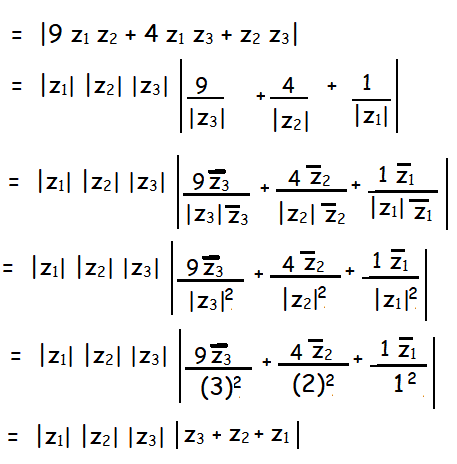COMPLEX NUMBERS WITH INEQUALITY PROBLEMS
Subscribe to our ▶️ YouTube channel 🔴 for the latest videos, updates, and tips.
Question 1 :
If | z |= 3, show that 7 ≤ | z + 6 − 8i | ≤ 13.
Solution :
Using the property of complex numbers
|z1 + z2| ≤ |z1| + |z2|
|z1 + z2| ≥ |z1| - |z2|
| z + 6−8i | ≤ | [|z| + |6 − 8i|] |
≤ | 3 + √62 + (-8)2|
≤ |3 + √(36 + 64)|
≤ |3 + √100|
≤ |3 + 10|
≤ 13
| z + 6−8i | ≥ |z| - |6 − 8i|
≥ |3 - √(36 + 64)|
≥ |3 - √100|
≥ |3 - 10|
≥ 7
7 ≤ | z + 6−8i | ≤ 13
Question 2 :
If |z| = 1, show that 2 ≤ |z2 - 3 | ≤ 4
Solution :
|z2 - 3 | ≤ ||z2| + |- 3 | |
|z2 - 3 | ≤ ||z|2 + 3|
|z2 - 3 | ≤ |12 + 3|
|z2 - 3 | ≤ 4
|z2 - 3 | ≥ ||z2| - | 3||
|z2 - 3 | ≥ |1 - 3|
|z2 - 3 | ≥ 2
2 ≤ |z2 - 3 | ≤ 4
Hence proved.
Question 3 :
If | z - (2/z) | = 2, show that the greatest and least value of | z | are √3 + 1 and √3 − 1 respectively
Solution :
|z - (2/z) | = 2
|(z2 - 2)/z | = 2
Question 4 :
If z1, z2 and z3 are three complex numbers such that |z1| = 1, |z2| = 2, |z3| = 3 and |z1 + z2 + z3| = 1, show that |9 z1 z2 + 4 z1 z3 + z2 z3| = 6
Solution :

Now applying the given values, we get
= 1(2)(3) (1)
= 6
Hence proved.
Question 5 :
If the area of the triangle formed by the vertices z, iz , and z + iz is 50 square units, find the value of z .
Solution :
Length of three sides
z & iz = √(z-0)² + (0-z)² = |z|√2 = a
z & z + iz = √(z-z)² + (0-z)² = |z| = b
z & z + iz = √(0-z)² + (z-z)² = |z| = c
The sides are |z|√2 , |z| & |z|
s = (a + b + c)/2


Area of triangle = 50 sq units
|z|²/2 = 50
|z|² = 100
|z| = 10
Hence the value of |z| = 10.
Question 6 :
Show that the equation z3 + 2z bar = 0 has five solutions.
Solution :
z3 + 2z bar = 0
z = x + iy
(x + iy)3 + 2(x - iy) = 0
x3 + 3x2(iy) + 3 x(iy)2 + (iy)3 + 2x - i2y = 0
x3 + i3x2y - 3 xy2 - iy + 2x - i2y = 0
(x3 - 3 xy2 + 2x) + i(3x2y - y - 2y) = 0
(x3 - 3 xy2 + 2x) + i(3x2y - 3y) = 0 + i0
By equating the real and imaginary parts, we get
x3 - 3 xy2 + 2x = 0 ----(1)
3x2y - 3y = 0 ----(2)
3y(x2 - 1) = 0
y = 0, x = 1, -1
By applying the two different values of x in (1), we get 2 different values of y.
Hence, it has 5 solutions.
Subscribe to our ▶️ YouTube channel 🔴 for the latest videos, updates, and tips.
Kindly mail your feedback to v4formath@gmail.com
We always appreciate your feedback.
About Us | Contact Us | Privacy Policy
©All rights reserved. onlinemath4all.com

Recent Articles
-
10 Hard SAT Math Questions (Part - 42)
Dec 30, 25 05:52 AM
10 Hard SAT Math Questions (Part - 42) -
10 Hard SAT Math Questions (Part - 38)
Dec 29, 25 04:21 AM
10 Hard SAT Math Questions (Part - 38) -
10 Hard SAT Math Questions (Part - 39)
Dec 28, 25 11:20 PM
10 Hard SAT Math Questions (Part - 39)
